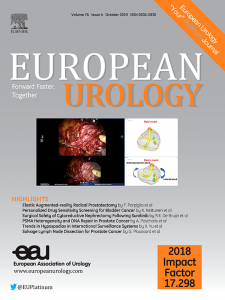birt - hogg - dub综合征肾肿瘤:综合组织病理学、体积和单细胞转录组学分析
IF 25.3
1区 医学
Q1 UROLOGY & NEPHROLOGY
引用次数: 0
摘要
背景与目的目前尚不清楚在birt - hogg - dub本文章由计算机程序翻译,如有差异,请以英文原文为准。
Renal Neoplasia in Birt-Hogg-Dubé Syndrome: Integrated Histopathologic, Bulk, and Single-cell Transcriptomic Analysis
Background and objective
It is unclear whether historically diagnosed “hybrid tumors” in patients with Birt-Hogg-Dubé syndrome (BHD) represent unique tumors or a hybrid between oncocytoma and chromophobe renal cell carcinoma (Ch-RCC), and existing diagnostic criteria are ambiguous. We aimed to understand the spectrum of folliculin gene (FLCN) alterations, outcomes for BHD patients with kidney tumors, and the biology of FLCN-mutated tumors (FMTs) to refine diagnostic algorithms.Methods
Germline testing for FLCN alterations and outcomes for 20 BHD patients with 84 kidney tumors were evaluated. Renal tumors were profiled for histopathology and analyzed using a combination of next-generation sequencing, bulk/single-cell transcriptomic analysis, and immunohistochemistry (IHC).Key findings and limitations
Ninety unique germline FLCN variants in 234 unrelated families included rare deletion events (14/234, 6%), including those of the promoter region. Most patients (17/19, 90%) met the National Comprehensive Cancer Network criteria for germline testing. Almost all cases represented indolent FMTs (n = 81), with metastases seen in two (of three) nonconventional renal cell carcinoma patients. FMTs showed a gene expression profile distinct from both oncocytoma and Ch-RCC characterized by four distinct L1CAM–/FOXI1+ and two L1CAM+/FOXI1– cell populations that showed GPNMB overexpression. IHC panels that include L1CAM, SOX9, and GPNMB can be a reliable screen for conventional FMTs. Limitations include the absence of external transcriptomic datasets to avoid batch effects.Conclusions and clinical implications
Our results highlight the gaps in current clinical germline testing strategies for BHD, which should include promoter deletion events. Multimodal molecular profiling results can be translated into routine clinical practice using IHC biomarkers to improve the diagnosis of BHD and to separate indolent “conventional” FMTs from “nonconventional tumors,” which may be clinically aggressive.求助全文
通过发布文献求助,成功后即可免费获取论文全文。
去求助
来源期刊

European urology
医学-泌尿学与肾脏学
CiteScore
43.00
自引率
2.60%
发文量
1753
审稿时长
23 days
期刊介绍:
European Urology is a peer-reviewed journal that publishes original articles and reviews on a broad spectrum of urological issues. Covering topics such as oncology, impotence, infertility, pediatrics, lithiasis and endourology, the journal also highlights recent advances in techniques, instrumentation, surgery, and pediatric urology. This comprehensive approach provides readers with an in-depth guide to international developments in urology.
 求助内容:
求助内容: 应助结果提醒方式:
应助结果提醒方式:


